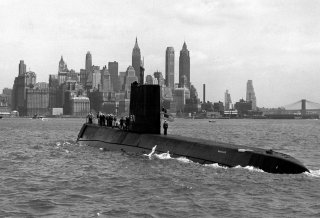2,507 Dives: The USS Nautilus Was a Nuclear Submarine Trailblazer
During its career, it had made 2,507 dives and traveled 513,550 miles without incident.
Key Point: In an era where technological progress was rapid, Nautilus was a stunning achievement. Just nine years after the atomic bomb test at Alamogordo, New Mexico, Nautilus was underway and using nuclear power.
In 1948, the U.S. Navy established a Nuclear Power Branch, kicking off a revolution in ship propulsion. The department, headed by legendary naval officer Adm. Hyman Rickover, would oversee the construction of a unique ship, the first to take advantage of the benefits of nuclear propulsion. That ship was the nuclear submarine USS Nautilus.
(This first appeared back in 2017.)
The U.S. Navy, used to traveling long distances to fight its battles, was an early fan of nuclear propulsion. Nuclear power promised to eliminate the need for massive quantities of ship fuel, reducing the logistical demands of a fleet at sea. As Norman Polmar and K. J. Moore explained in their book Cold War Submarines, nuclear-powered submarines would have a virtually unlimited range, be faster above and below the surface of the ocean, generate more power per volume than diesel engines, and operate more easily than diesel engines.
Construction of a nuclear-powered submarine—the first nuclear-powered vessel ever—began in 1951. The submarine, Nautilus, would be powered by a S2W Submarine Thermal Reactor, a pressurized water atomic reactor capable of generating up to 13,400 horsepower. This would give the Nautilus a maximum speed of twenty-three knots. The ship would be 320 feet long, eighty-two feet longer than the conventionally powered Tang class, and displace four thousand tons submerged, twice as much as the Tangs. It had a crew of 105.
While Nautilus would be powered by an all-American nuclear power plant, its hull was German in origin. The United States had not yet developed the teardrop-shaped hull design that is still in use today, and Nautilus resembled the German Type XXI U-boat, the most highly advanced design of the war and the basis for many immediate postwar submarine designs, including the Soviet Whiskey class and UK Porpoise class. Although the use of nuclear power gave it a five-knot advantage over the conventionally powered Tang class, the Type XXI–inspired hull was a compromise between surface and subsurface handling, preventing Nautilus from reaching nuclear power’s promise of thirty-plus-knot sustained speeds.
Nautilus was formally commissioned into service on September 30, 1954, but it didn’t take to sea for months. Its reactor was started up on December 30, and on January 17, 1955, it finally left the pier, sending the signal UNDERWAY ON NUCLEAR POWER. It quickly broke distance and speed records, including a submerged trip from New London, Connecticut, to Puerto Rico, a distance of 1,381 miles in ninety hours, or an average of fifteen knots.
Still, Nautilus wasn’t perfect. Submerged, the flow of water behind its sail produced vibration, as did speeds above sixteen knots. According to Polmar and Moore, it was necessary to shout to be heard in the torpedo room when the ship was in the fifteen-to-seventeen-knot range. Collectively, the vibrations were so bad that the submarine’s sonar was considered unusable above eight knots. The Navy promptly turned lemons into lemonade by declaring the submarine “a floating operational laboratory for a wide variety of self-noise investigations.”
Nautilus was originally conceived as a test-bed submarine to demonstrate that nuclear power was safe and effective, and as such was planned to be unarmed. Fortunately, the decision was quickly reversed, and it was given what was considered a standard armament suite for its time. Six 533-millimeter torpedo tubes were built into the bow, along with room to store up to twenty-six torpedoes.
In 1958, the United States government pushed to have a nuclear-powered submarine reach the North Pole, both as a response to the Sputnik satellite launch and to prove that Polaris-missile-armed submarines could operate above the Arctic Circle. On July 23, 1958, Nautilus became the first ship to reach the North Pole—above or below the ice. Nautilus traveled from Hawaii to Greenland, perhaps the most unusual voyage undertaken thus far by any ship.
After an overhaul in 1960, Nautilus joined the Atlantic Fleet and served as a regular attack submarine. One of its first operations of note was participation in the blockade of Cuba during the Cuban Missile Crisis. Still, the combination of vibration noise, and a hull design quickly rendered obsolete by the experiments conducted on the USS Albacore, meant it was more of a second-line ship, participating in antisubmarine warfare exercises far from Soviet forces. It remained in service until 1979, and in 1985 was opened to the public as a permanent exhibition at the Submarine Force Library and Museum.
In an era where technological progress was rapid, Nautilus was a stunning achievement. Just nine years after the atomic bomb test at Alamogordo, New Mexico, Nautilus was underway and using nuclear power. Not only that, but the submarine proved that nuclear propulsion was safe and efficient, paving the way for an all-nuclear U.S. Navy submarine fleet. During its career it had made 2,507 dives and traveled 513,550 miles without incident. A trailblazer, Nautilus’s success ensured that the U.S. submarine fleet would maintain technological superiority over its Soviet Navy for the remainder of the Cold War.
Kyle Mizokami is a defense and national-security writer based in San Francisco who has appeared in the Diplomat, Foreign Policy, War is Boring and the Daily Beast. In 2009, he cofounded the defense and security blog Japan Security Watch. You can follow him on Twitter: @KyleMizokami.
Image: Flickr.

